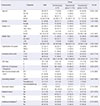1. Jo HY. The effect of cuff pressure of endotrachel tube on postoperative sore throat in women receiving laparoscopic surgery [master's thesis]. Jeonju: Chonbuk National University;2013. 1–42.
2. Hu BJ, Xu J, Zhao XH, Zhang NN, Pan MZ, Bo LL, et al. Impact of endotracheal tube cuff pressure on postoperative sore throat: A systematic review and meta-analysis. Journal of Anesthesia and Perioperative Medicine. 2016; 3(4):171–176.

3. Jaensson M, Olowsson LL, Nilsson U. Endotracheal tube size and sore throat following surgery: A randomized–controlled study. Acta Anaesthesiologica Scandinavica. 2010; 54(2):147–153. DOI:
10.1111/j.1399-6576.2009.02166.x.


4. Lee JY, Sim WS, Kim ES, Lee SM, Kim DK, Na YR, et al. Incidence and risk factors of postoperative sore throat after endotracheal intubation in Korean patients. Journal of International Medical Research. 2017; 45(2):744–752. DOI:
10.1177/0300060516687227.

5. Na HK, Yoon HS. The effect of cuff pressure of endotrachel tube on postoperative sore throat. Journal of Korean Academy of Adult Nursing. 2009; 21(5):538–546.
6. Mogal SS, Baliarsing L, Dias R, Gujjar P. Comparison of endotracheal tube cuff pressure changes using air versus nitrous oxide in anesthetic gases during laparoscopic abdominal surgeries. Brazilian Journal of Anesthesiology. 2018; 68(4):369–374. DOI:
10.1016/j.bjane.2018.01.015.


7. Chen KT, Tzeng JI, Lu CL, Liu KS, Chen YW, Hsu CS, et al. Risk factors associated with postoperative sore throat after tracheal intubation: An evaluation in the postanesthetic recovery room. Acta Anaesthesiologica Taiwanica. 2004; 42(1):3–8.

8. Hara K, Maruyama K. Effect of additives in lidocaine spray on postoperative sore throat, hoarseness and dysphagia after total intravenous anaesthesia. Acta Anaesthesiologica Scandinavica. 2005; 49(4):463–467. DOI:
10.1111/j.1399-6576.2005.00632.x.


9. Maruyama K, Yamada T, Hara K. Effect of clonidine premedication on postoperative sore throat and hoarseness after total intravenous anesthesia. Journal of Anesthesia. 2006; 20(4):327–330. DOI:
10.1007/s00540-006-0421-x.


10. Al-Qahtani AS, Messahel FM. Quality improvement in anesthetic practice--incidence of sore throat after using small tracheal tube. Middle East Journal of Anaesthesiology. 2005; 18(1):179–183.
11. Irwin RS, Rippe JM. Irwin and Rippe's intensive care medicine. 5th ed. Philadelphia: Lippincott Williams & Wilkins;2003. p. 1–16.
12. Combes X, Schauvliege F, Peyrouset O, Motamed C, Kirov K, Dhonneur G, et al. Intracuff pressure and tracheal morbidity: Influence of filling cuff with saline during nitrous oxide anesthesia. Anesthesiology. 2001; 95(5):1120–1124. DOI:
10.1097/00000542-200111000-00015.

13. Tu HN, Saidi N, Leiutaud T, Bensaid S, Menival V, Duvaldestin P. Nitrous oxide increases endotracheal cuff pressure and the incidence of tracheal lesions in anesthetized patients. Anesthesia and Analgesia. 1999; 89(1):187–190.


14. Seegobin RD, van Hasselt GL. Endotracheal cuff pressure and tracheal mucosal blood flow: Endoscopic study of effects of four large volume cuffs. British Medical Journal. 1984; 288(6422):965–968.


15. Kang H, Kim KJ, Baek CW, Woo YC, Kim JY, Park SG. The effect of cuff pressure of laryngeal tube on postoperative sore throat after general anesthesia using N2O. Korean Journal of Anesthesiology. 2006; 50(3):266–271. DOI:
10.4097/kjae.2006.50.3.266.

16. The Korean Society of Anesthesiologists. Anesthesiology. Seoul: Yeomoongak;2002. p. 123–125.
17. Morgan GE, Mikhail MS, Murray MJ. Clinical Anesthesiology. 4th ed. New York: Lange Medical Books/McGraw Hill;2006. p. 1–1105.
18. Maino P, Dullenkopf A, Bernet V, Weiss M. Nitrous oxide diffusion into the cuffs of disposable laryngeal mask airways. Anaesthesia. 2005; 60(3):278–282. DOI:
10.1111/j.1365-2044.2004.04072.x.


19. Kim SH, Song JE, Chung KH, Lee HR, Kim MG, Yang HJ. The Influence of nitrous oxide on postoperative bowel function recovery for gynecologic patients. Anesthesia and Pain Medicine. 2007; 2(3):156–159.
20. Koşar Ö, Şen Ö, Toptaş M, Mısırlıoğlu G, Aydın N, Gür EK, et al. Effect of nitrous oxide anaesthesıa on endotracheal cuff pressure. The Medical Bulletin of Haseki. 2017; 55(1):37–41. DOI:
10.4274/haseki.3168.

21. Chou KH, Huh KW, Hyun HS, Kang HG. The effects of nitrous oxide on volume and pressure of endotracheal tube cuffs during general inhalation anesthesia. Korean Journal of Anesthesiology. 1997; 32(1):62–66.

22. Cohen J. Statistical power analysis for the behavioral sciences. 2nd ed. Hillsdale (NJ): Lawrence Erlbaum Associates;1988. p. 284–285.
24. Min YK, Choi JW, Kim LS. ENT clinic for primary care. Seoul: Iljogak;2005. p. 199–200.
25. Moon YI. A clinical study of patients with hoarseness. Journal of the Korean Society of Laryngology, Phoniatrics and Logopedics. 1989; 3(1):13–21.
26. Stout DM, Bishop MJ, Dwerstec JF, Cullen BF. Correlation of endotracheal tube size with sore throat and hoarseness following general anesthesia. Anesthesiology. 1987; 67(3):419–421.


27. Somri M, Fradis M, Vaida S, Malatskey S, Gaitini L. Simple on-line endotracheal cuff pressure relief valve. Annals of Otology, Rhinology & Laryngology. 2002; 111(2):190–192. DOI:
10.1177/000348940211100215.

28. Stewart SL, Secrest JA, Norwood BR, Zachary R. A comparison of endotracheal tube cuff pressures using estimation techniques and direct intracuff measurement. AANA Journal. 2003; 71:443–447.

29. The Korean Society of Anesthesiologists. Anesthesiology & pain medicine. 2nd ed. Seoul: Yeomoongak;2010. p. 188.
30. Czarnecki ML, Turner HN, Collins PM, Doellman D, Wrona S, Reynolds J. Procedural pain management: A position statement with clinical practice recommendations. Pain Management Nursing. 2011; 12(2):95–111. DOI:
10.1016/j.pmn.2011.02.003.








 PDF
PDF ePub
ePub Citation
Citation Print
Print






 XML Download
XML Download